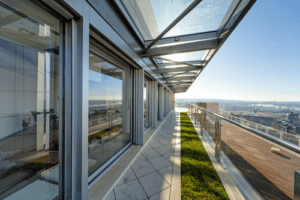Business owners and operators face a great variety of problems that arise daily. Some of them are extremely important and can affect the well-being of the business, while others are ultimately irrelevant. Your power bill, and consequently your HVAC system, is one of the important ones. As they are used day after day, commercial heating and cooling units are one of those modern essentials that can wind up either wasting a lot of money or generating customer complaints.
Building load and room loads are calculated measurements of the area an HVAC system will target. The volume of air in a room can vary drastically with a little extra square footage on the floor or vaulted ceilings. To address this, skilled HVAC installers will help you determine the load of the space that you’re looking to heat or cool and adjust the system accordingly.
What Can Happen with Commercial Heating and Cooling Units Not Suited to Your Business?
 With HVAC systems, there’s a “Goldilocks zone” where things are just right. When a system has sufficient power, you find the perfect balance between cost and comfort, but changes in environmental factors can cause problems if your system isn’t flexible enough.
With HVAC systems, there’s a “Goldilocks zone” where things are just right. When a system has sufficient power, you find the perfect balance between cost and comfort, but changes in environmental factors can cause problems if your system isn’t flexible enough.
If your system isn’t strong enough to deal with the heating and cooling needs you face, there is a real cost to your business. If you’ve been in a restaurant during the height of summer when the HVAC system is pushing hard but just not cutting it, you know that it’s a restaurant you’re not likely to visit again until fall rolls around. The reverse case is true in winter if the heater can’t keep up with the in-and-out of customers and employees moving through the doorway.
Commercial heating and cooling units that aren’t flexible enough can also leave rooms that are perennially too hot or too cold. Additionally, extreme weather variance can reveal weaknesses in an HVAC system. The added strain can also damage your system and force you to seek professional repairs. These situations highlight why it’s best to have a little more power in your system than the average temperature needs suggest based on your building load.
How Is Building Load Determined?
In many cases, building load is determined by using basic math and calculating an approximate cubic area and default pressure. This calculation is a straightforward, low-intensity method to find it, but doesn’t yield the most accurate results. There are systems that take a regimented and detailed approach to determine it, including as much detail as is desired (even down to specific wall and roof constructions). Generally, taking the area and considering the regular weather patterns for your city will split the difference and result in a useful, relevant calculation.
Once you’ve established building load, you can determine how much power you need. This step helps you ascertain what kind of HVAC system you need. If you’ve identified any rooms that tend are more exposed to external conditions, those rooms may also need more potent systems or greater attention given to them.
Choosing the Right Kind of System
There are several kinds of HVAC systems, each offering different solutions. When you have accurate information about your building load and HVAC needs, you can make reliable and effectual decisions as to which kind of system to choose. Three major types of systems are VAV systems with packaged rooftop units, chillers with cooling towers and boilers, and water-source heat pump systems with cooling towers and boilers.
In the past, VAV systems have suffered when installed for building loads that didn’t warrant the maximum capacity of the system. This effect is due to decreased efficiency with partially-open boxes. Modern systems can address this with automation, but it is still a fundamental consideration for VAV heating and cooling systems.
Chillers with cooling towers and boilers tend to be better able to address situations where building load falls short of system capacity. The temperature control medium is a line of pipes that move through each room and up to the roof, where heat is either expelled from the system to cool or put into the system for heating. There is a more expensive variant which allows for independent temperature controls for each room.
The most effective solution for all building loads is the water-source heat pump systems. These systems enable you to efficiently move heat from one room to another, resulting in the greatest possible efficiency. As a baseline, if this heat redistribution is enough to handle your building’s heating and cooling needs, there is no need to add or remove heat from the system. As this is not always the case, the boiler and cooling tower allow the system to provide tremendous amounts of temperature control as needed.
Bringing It All Together
When it comes to commercial heating and cooling units, it’s only possible to make the right decision when you have the best information. Take the time to research weather patterns around your location and estimate your building load from there. With good information and the latest developments in HVAC technology, you can save money while ensuring that all your employees and customers are comfortable every time they’re in your business.

